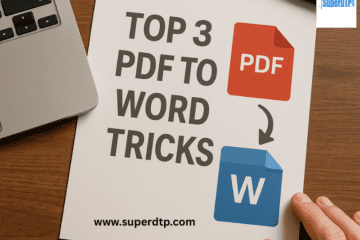In today’s fast-paced digital world, businesses are rapidly expanding their global reach, targeting diverse markets with unique language and cultural preferences. As companies seek to engage with international audiences, the demand for multilingual desktop publishing (DTP) has surged. This process involves adapting and designing content in various languages to ensure consistent branding, effective communication, and optimal user experience across digital platforms.
The transition from print to digital media has revolutionized the way businesses communicate with their audiences. With the rise of websites, mobile apps, e-books, and online marketing, multilingual DTP has become indispensable for companies aspiring to conquer the global marketplace.
Desktop publishing (DTP) is the creation of documents using dedicated software on a personal (desktop) computer. Initially utilized primarily for print publications, desktop publishing software now aids in crafting diverse online content as well. Capable of generating page layouts and creating text and image content akin to traditional typography and printing, this technology empowers individuals, businesses, and organizations to self-publish an array of content ranging from menus to magazines to books, all without incurring the costs associated with commercial printing.
PAST
From its roots in the Middle Ages, layout design has evolved significantly. What was once the provenance of monasteries spread to the office, and later, personal computers. While the overarching objectives of publishers remain unchanged—to engage an audience and convey significant messages—medieval illuminated manuscripts provide early instances of stunning page layouts. Surprisingly modern in their approach, the manuscript creators would meticulously strategize the page’s overall design, incorporating intricately adorned drop capitals and decorative borders. Subsequently, they would sketch straight lines on parchment or vellum to delineate the placement of text.
Desktop publishing as a field began with the invention of the personal (desktop) computer. Early software programs enhanced the ease and speed with which brochures, magazines, and papers could be laid out and designed. Moreover, the advent of Unicode fonts accommodating diacritical marks and special characters enabled the emergence of multilingual desktop publishing.
Multilingual desktop publishing emerged in the late 1980s and early 1990s in response to the increasing globalization of businesses and the need for documents to be created in multiple languages.
PRESENT: DIGITALIZATION AND AUTOMATION
In recent years, digitalization and automation have revolutionized the field of multilingual desktop publishing, making it more efficient, accessible, and versatile than ever before.
Digital platforms: desktop publishing software, such as Adobe InDesign, QuarkXPress, and Affinity Publisher, have embraced multilingual capabilities. These platforms allow designers to work seamlessly with multiple languages within the same document, eliminating the need for separate files or manual integration.
Integration of translation tools: with the rise of machine translation services like Google Translate, Microsoft Translator, and Deepl, designers can easily incorporate translated text into their layouts.
Cat (computer-assisted translation) tools: cat tools, such as SDL Trados, memoQ, and Across, have become indispensable for professional translators and desktop publishers.
Global collaboration: digitalization has enabled seamless collaboration between team members and clients located in different parts of the world. Cloud-based platforms like Google Workspace and Microsoft Office 365 allow real-time editing, commenting, and sharing of multilingual documents, enhancing productivity and communication.
CHALLENGES
In today’s ever-globalizing technological landscape, businesses are earnestly endeavoring to engage and resonate with diverse markets worldwide. Multilingual desktop publishing (DTP) stands out as a crucial instrument in this pursuit, facilitating the adaptation or translation of content into multiple languages to cater to varied audiences. While this surge in multilingual communication presents unparalleled opportunities, it also presents distinct challenges.
Inconsistent fonts
The majority of fonts designed in English lack support for Asian writing systems and Middle Eastern scripts.
Language complexity
Each language comes with its own set of unique complexities in grammar, syntax, and style. Adapting content can pose significant challenges, from languages such as Arabic, which reads right-to-left, to those like Mandarin, which feature complex glyphs.
Cultural differences
What makes perfect sense in one culture could be entirely out of context or even offensive in another. Cultural nuances significantly impact the imagery, color choices, and overall design of a document.
Layout issues
The expansion and contraction of text in various languages can disturb the original layout, necessitating meticulous formatting adjustments.
FUTURE TRENDS
Multilingual desktop publishing (DTP) has transformed the manner in which businesses engage with diverse audiences globally. With the ever-increasing demand for localized content, it’s crucial to stay abreast of the latest trends and technologies shaping the industry.
As technology continues to evolve, so too does the landscape of desktop publishing for localization.
These technologies have the potential to improve efficiency and accuracy, making it easier for businesses to deliver high-quality localized content in a shorter amount of time.
However, these advancements also present challenges, such as the need for ongoing training and development of DTP professionals.
The rise of cloud-based software tools has been one of the most significant trends in desktop publishing for localization.
This is particularly important for global teams that need to work on the same document simultaneously.
Another trend that is emerging in desktop publishing for localization is the use of artificial intelligence (AI) and machine learning (ML).
Ai and ml are being used to automate repetitive tasks like formatting and layout.
This reduces the time required to complete a project and also reduces the chances of errors.
Automated layout and formatting solutions are another trend in desktop publishing for localization.
These solutions use templates and predefined formatting rules to create consistent layouts for translated documents.
The future of desktop publishing for localization is expected to witness increased incorporation of emerging technologies.
CONCLUSION
Multilingual desktop publishing has evolved from traditional print to digitalization, leveraging automation and AI. While challenges persist, such as font consistency and cultural nuances, emerging trends like cloud-based collaboration and AI-driven automation promise a more efficient and accurate future for global communication and localization efforts.
Super DTP Ltd is a specialized desktop publishing agency located in Gabrovo Bulgaria, offering book publishing, multilingual DTP, and E-learning localization services to translation agencies and localization companies worldwide! Check our services at www.superdtp.com or contact us at dtp.bulgaria@gmail.com for further details


